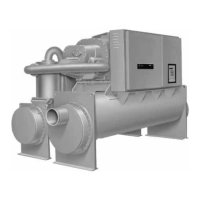Current Transformer and Current Input
30 RTHC-SVD01B-EN
5. Utilizing the schematic wiring diagram, locate the termination of
the transformer's wiring into the Phoenix connector on the Starter
module. Unplug the appropriate connector from the Starter mod-
ule.
CUATION
Equipment Damage!
Current Transformers can be damaged and high voltages can result due
to running the compressors without a suitable burden load for the CTs.
This load is provided by the Starter module. Take care to properly recon-
nect the CT's back to the Phoenix connector prior to attempted start of
the compressor.
6. Using a digital volt-ohmmeter, measure the resistance of the
transformers by probing the appropriate wires of the Phoenix con-
nector. Use the leads on the meter and probe the screws used in
the Phoenix connector to measure the resistances.
7. Refer to 4-1 which lists the normal resistance range for each
extension of current transformer. Check the measured resistance
against the value listed per transformer extension. If the resis-
tance is within tolerance, the transformer and Phoenix connector
can be considered good. Go to step 9.
8. If the resistance reading is out of tolerance, the problem is either
with the transformer, its wiring, or the Phoenix connector. First,
double check the schematic to be sure you are working on the
proper lead pair. Then disconnect the leads of the particular trans-
former at the Phoenix connector and repeat the resistance mea-
surement by stripping insulation from the wire's end. Once the
fault has been isolated, install a new transformer and/or install a
new phoenix connector.
More than one current transformer is terminated to a single Phoe-
nix connector. When replacing, take care to note the proper posi-
tions of the respective transformer wire terminations on the
Phoenix connector for the re-termination. The current transform-
ers are polarity and directionally sensitive. The transformer lead
wiring is #22 AWG, UL 1015 600V. If the fault can be isolated to
the current transformer or its wiring apart from the connector, the
connector can be reused.
The CT’s are polarity sensitive. They have a directional dot that
must face away from the motor or into the line side.
9. If the transformer/connector resistance proves accurate, recheck
the resistance with the connector held at different angles and with
a light lead pull (less than 5 lb.) to test for an intermittent connec-
tion.

